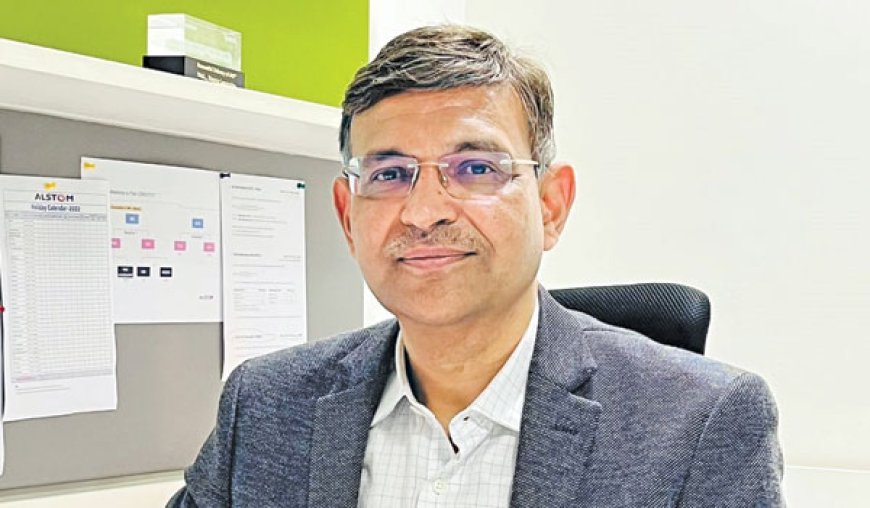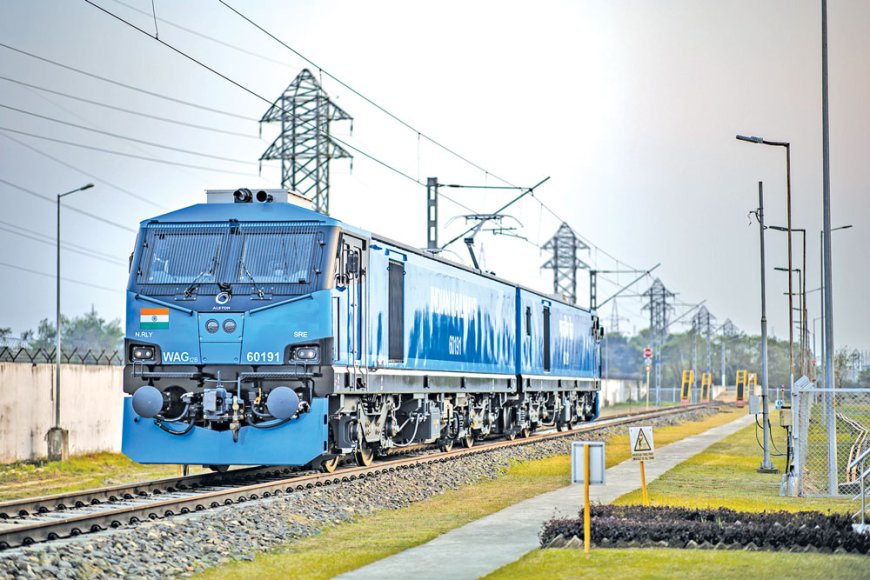The demand for smart and sustainable public transport is expected to increase exponentially.

Anil Saini
Managing Director, Rolling Stock and Components, Alstom India
What are your views on the developments happening in the Indian railway infrastructure?
The current developments in railway infrastructure are extremely encouraging and paint a very positive outlook for the future. India has committed to reach net-zero emissions by 2070. In line with this ambition, the country is looking to increase the amount of freight moved by Indian Railways from about 26 percent in 2015 to 45 percent by 2030, while transforming into the world’s first ‘Green Railways’ by 2030. With 95% of the railway lines now electrified, we're seeing significant advances in sustainability and operational efficiency.
The commissioning of the dedicated freight corridors is a crucial part of the National Logistics Policy, as it aims to reduce logistics costs from the current 15 per cent to 8 per cent of GDP, by 2030. Indian Railways is also considering the development of three additional dedicated freight corridors, marking a significant leap in the country's logistics infrastructure, and significantly boosting economic activity. This development, alongside the growing fleet of high-powered electric locomotives for freight service, showcases the government's commitment to modernizing the infrastructure and enhancing connectivity. These corridors aim to accelerate freight movement and alleviate congestion on existing tracks and promote sustainability.
In addition to infrastructure enhancements, the introduction of high-speed rail, exemplified by the Vande Bharat Express, marks a significant milestone in the nation's transportation history. This presents a great opportunity for India’s railway manufacturing sector, which is one of the most comprehensive railway manufacturing ecosystems in the world. India produces a vast array of infrastructure and equipment for its own use and exporting it across the globe as well. Rolling stock manufactured in Bihar, Tamil Nadu or Gujarat now operate across the country. Trains built in Andhra Pradesh have been deployed by Metro systems as far away as Canada and Australia.
Thus, India is a growing market, both for mainline railways and urban rail-based mobility. The interim Union Budget 2024-25 also promises to drive development and innovation, taking India’s infrastructure to the next level and by bringing together its transportation ecosystem for rail, road, aerospace and more to benefit individuals and businesses alike.
Alstom is committed to supporting India’s transition to more innovative, sustainable, and accessible mobility systems. As the frontrunners in sustainable mobility and drivers of India’s rail revolution, the announcement of metro and NaMo Bharat expansion, three major railway corridor program and transformation in existing rail ecosystem will create opportunities for us to introduce world class rolling stock, rail equipment and infrastructure, signalling and services in India. It will not only strengthen the overall efficiency of transportation network but also improve the reliability and safety of passenger trains.

What are the latest trends in metro rail services in India? How is the sector growing in India?
The metro rail sector in India is experiencing robust growth driven by the increasing population and the corresponding need for efficient and sustainable public transport systems. The Government of India remains committed to enhancing urban mobility and mitigating traffic congestion, a commitment evident by the expansive growth of metro networks across multiple cities. Currently, India boasts of a total operational metro network of 845 km, across 15 cities. Additionally, there are about 462 km under construction, 372 km recently approved, and 1,056 km proposed for future development. With this, India's metro network is poised to expand to approximately 2,750 km in the coming years, significantly enhancing urban mobility across the country. Alstom has had the privilege of contributing to almost every metro project in India.
In addition to expanding metro services, India is advancing towards developing a Regional Rapid Transit System (RRTS). Delhi-Ghaziabad-Meerut RRTS corridor, which is India's first semi-high-speed regional rail service, is ushering in a new era of regional connectivity. This project is already boosting urbanisation, leading to better-planned urban centres, and fostering economic growth and regional integration, wherever it is operational. Additionally, it will play a key role decongesting the national capital, enhance the travel experience and become an enabler of employment opportunities, particularly for women. In the long run, this project will serve as an example of how a fast and efficient railway system can connect multiple cities in a large urban area and transform the entire region into a well-connected, sustainable, developed, and economically vibrant place. Its success in the NCR will not only lead to other regions in India trying to emulate its success but serve as an example for growing cities across the globe.
What are the latest technology developments happening in railways and metro services?
With growing population and rapid urbanization, the demand for public transport that is smart and sustainable is expected to increase exponentially. In terms of the future several technologies such as AI, IoT, Cloud Computing, next generation telecommunication and cyber security will play a stronger role in rail mobility architecture. As for the train itself, automatic and autonomous are a reality today in many cities and even suburban areas around the world. Europe’s most heavily used regional line in Paris, with 1.4 million daily journeys, is the first automated suburban train in the world (built by Alstom). Driverless technology improves the efficiency, safety, and overall performance of rail transportation systems.
Alstom provides Autonomous Mobility or Automatic Train Operation, which is an operational and safety enhancement in rail that takes the guesswork, human error, and variables out, making them more efficient, accurate, and reliable than ever. Equipped with digital tools, cutting-edge sensors, powerful software, and deep experience in driverless transport, Alstom is at the forefront of the development of autonomous systems. For example, we have a strong experience in fully automated and driverless metros with over 50 systems worldwide currently, and driverless operation experience that stretches back to the 1970s. Very recently, we started production for Chennai Metro Phase 2, which will be the first to have driverless trains from day one of passenger service in India. These trains are conceptualized and designed for driverless from day one, i.e., GoA4 mode whereas other metro projects in India initially started with train operator (GoA2 mode) and later converted them to a driverless train (GoA4). Alstom has delivered driverless metro trains in several parts of the world including, Singapore, Sydney, Dubai, Montreal and many more.
What are the latest technology innovations from Alstom for railways and metro services?
From leading signalling, to supplying largest number of metro trains, to dominating engineering and R&D space, Alstom is India’s true partner in the mobility space. Currently, we are the only multinational sustainable mobility provider in India, to have a comprehensive portfolio of offerings to meet customer-specific needs, from cost-efficient mass-market platforms to high-end technological innovations. We were the first to invest in hydrogen solutions. Today, we are the only rail player offering the entire range of low-emission rail technologies, including hydrogen (H2) trains, battery trains and electrification. Alstom also offers aluminium car-body technology for broad-gauge trains. These aesthetically modern trains offer improved safety, reliability, and passenger comfort. They are also lighter in weight, resulting in lower energy consumption and less wear and tear of tracks.
As the government is championing the development of modern, rail-based mass mobility solutions, we are committed to combine our global expertise with our strong experience in India, to provide tailor made solutions for the needs of this rapidly growing country. Our priority will continue to be on leading the market in the urban rail and signalling space. As more cities are looking to decongest their roads with metro solutions, our expertise will benefit the citizen in adopting safe and sustainable mass mobility solutions.
How do you look at the future of railways and metro rail systems in India?
India is an aspirational country and one of the fastest-growing emerging economies in the world. With India's population continuing to grow, there is a rising need for effective public transportation systems to meet the increasing demands. Our job is to provide a reliable and convenient option for commuters and encourage them to avail the facilities. There is a wide variety of last-mile connectivity options in urban cities and perhaps these services can be improved to increase the split favouring public transport.
Sustainable transport systems that offer a mix of safety, comfort, speed, and space will not only meet India’s needs for mobility, access, and economic growth without compromising the ability of future generations needs and environment protection but will also find traction with commuters. Thus, the future of railways and metro rail systems in India remains promising, with a strong focus on enhancing connectivity, efficiency, and sustainability.







